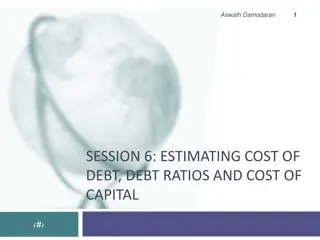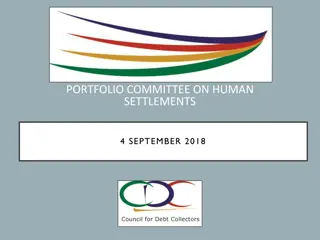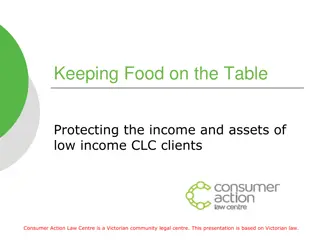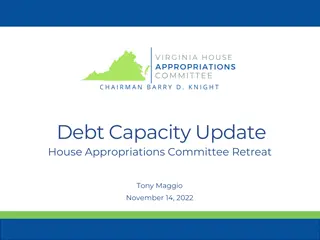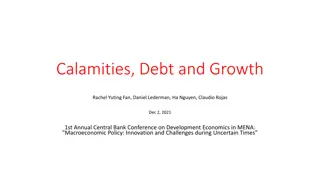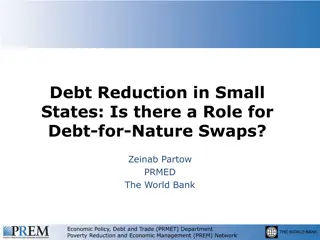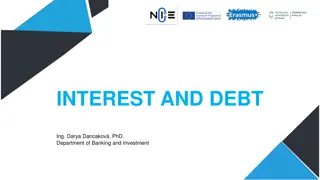Government Debt Management at the Zero Lower Bound: A Roundtable Discussion
This roundtable discussion in 2014 focused on the conflict between the Federal Reserve and the Treasury in managing government debt, particularly in the era of Quantitative Easing (QE). It explores the historical perspectives, a modern debt management framework, and potential solutions to resolve this conflict. The visuals presented show how the Fed's QE policies have impacted the supply of long-term securities, contrasting with the Treasury's actions in extending the average maturity of its borrowings.
Download Presentation

Please find below an Image/Link to download the presentation.
The content on the website is provided AS IS for your information and personal use only. It may not be sold, licensed, or shared on other websites without obtaining consent from the author. Download presentation by click this link. If you encounter any issues during the download, it is possible that the publisher has removed the file from their server.
E N D
Presentation Transcript
GOVERNMENT DEBT MANAGEMENT ATTHE ZERO LOWER BOUND 2014 ROUNDTABLEON TREASURY MARKETS AND DEBT MANAGEMENT ROBIN GREENWOOD, SAMUEL G. HANSON, JOSHUAS. RUDOLPH, & LAWRENCE H. SUMMERS
OUR PAPER I. Quantify Fed vs. Treasury conflict in QE era II. Fed vs. Treasury in historical perspective III. A modern framework for debt management IV. Ways to resolve Fed vs. Treasury conflict
PULLINGIN OPPOSITE DIRECTIONS 10-year duration equivalents, Change since Dec. 31, 2007 (% of GDP) The Fed s Quantitative Easing (QE) policies have reduced the net supply of long-term securities. 20% 15% 10% 5% 0% Fed QE: Treasuries, Agencies and MBS -5% 15.6% -10% -15% QE1 QE2 Twist QE3 -20% 2007 2008 2009 2010 2011 2012 2013
PULLINGIN OPPOSITE DIRECTIONS 10-year duration equivalents, Change since Dec. 31, 2007 (% of GDP) Meanwhile the Treasury was doing the opposite, extending the average maturity of its borrowings. 20% 15% Treasury: Maturity Extension 10% 5% 5.6% 0% Fed QE: Treasuries, Agencies and MBS -5% -10% -15% QE1 QE2 Twist QE3 -20% 2007 2008 2009 2010 2011 2012 2013
PULLINGIN OPPOSITE DIRECTIONS 10-year duration equivalents, Change since Dec. 31, 2007 (% of GDP) 20% 15% Treasury: Maturity Extension 10% 5% Net Impact: 10.1% 0% Fed QE: Treasuries, Agencies and MBS -5% -10% -15% QE1 QE2 Twist QE3 -20% 2007 2008 2009 2010 2011 2012 2013
PULLINGIN OPPOSITE DIRECTIONS 10-year duration equivalents, Change since Dec. 31, 2007 (% of GDP) 30% 24.9% 20% Treasury: Rising Debt Stock 10-year equivalents, % of GDP 10% 5.5% Maturity Extension 0% Fed QE -10% 15.6% -20% 2008 2009 2010 2011 2012 2013 2014
FEDVS. TREASURY HISTORICALLY Before 2008, the Fed s balance sheet was far smaller. As a result, the Fed had little impact on the maturity structure of the government s consolidated debts. 100% 75% Treasury 50% % of GDP > 5y 1-5y 25% < 1y 0% 1-5y < 1y > 5y Fed -25% 1936 1943 1950 1957 1964 1971 1978 1985 1992 1999 2006 2013
TRADITIONAL DEBT MANAGEMENT Treasury s traditional approach to determining the appropriate maturity of the debt traded off a desire to achieve low cost financing against the desire to limit fiscal risk. Low cost financing Limit fiscal risk Shorter-term Longer-term
TRADITIONAL DEBT MANAGEMENT Issuing short-term is cheaper because it allows Treasury to capture the liquidity premium on T-bills and to conserve on the term premium investors demand to hold long bonds. Liquidity premium on short-term T-bills, Basis points 200 150 bps 100 50 0 2002 2004 2006 2008 2010 2012 2014
TRADITIONAL DEBT MANAGEMENT Term Premium on 10-Year Zero-Coupon Treasuries (1990 to 2014) Twist QE2 QE3 QE1 3.0 2.0 1.0 % 0.0 -1.0 1991 1997 1993 1992 1996 1999 1994 2001 2007 1995 1998 2003 2002 2009 2004 1990 2006 2008 2005 2000 2011 2014 2010 2013 2012
TRADITIONAL DEBT MANAGEMENT What is fiscal risk? Refinancing risk If the government issues short-term, it is exposed to increases in interest rates If the government issues long-term, it locks in the cost of capital Rollover risk Failed auction Self-fulfilling bank run
TRADITIONAL DEBT MANAGEMENT The desire to limit fiscal risk looms larger when the overall debt burden rises. Low cost financing Limit fiscal risk Shorter-term Longer-term
TRADITIONAL DEBT MANAGEMENT Thus, Treasury has historically tended to extend the average maturity of the debt when debt-to-GDP rises. Much like the Treasury is doing today. 120% 100% 80% 60% 40% 20% 0% 1936 1943 1950 1957 1964 1971 1978 1985 1992 1999 2006 2013 Long-term share Treasury Debt/GDP
QUANTIFYING FISCALRISK: A COUNTERFACTUAL We argue that the fiscal risk generated by issuing short-term debt is less important than traditionally thought. Deficits in Counterfactual Case in which Treasury rolled over 3-mo Bills Actual Path of Deficits
TRADITIONAL DEBT MANAGEMENT Low cost financing Limit fiscal risk Shorter-term Longer-term
MODERN DEBT MANAGEMENT Modern debt management recognizes that the maturity of government debt may also be a valuable tool for managing aggregate demand and promoting financial stability. Limit fiscal risk Financial stability Aggregate demand Low cost Shorter-term Longer-term
DEBT MANAGEMENT CONFLICTS Objectives of modern debt management have been delegated to Treasury and Fed, which assign different policy weights to potentially conflicting goals Limit fiscal risk Treasury Fed Fed Financial stability Aggregate demand Treasury Low cost Shorter-term Longer-term
DEBT MANAGEMENT CONFLICTS Outside of the zero-lower-bound, Fed sterilization of Treasury debt management is imperfect workaround Fed gets last word using short rate But sterilization no longer possible at the ZLB Expansionary monetary policy at ZLB Extend average duration to mitigate fiscal risk (Treasury) Shorten average duration to bolster aggregate demand (Fed) Fed and Treasury in direct conflict over objectives If all weight on Fed s objective function, then Fed can presumably do more QE Realistically, dollar amount of QE limited by political considerations
BETTERSOLUTION Treasury and Fed release annual joint statement on combined public debt management strategy Forces each agency to internalize other s objectives Fed charged with routine tactical adjustments because of its expertise in open-market operations Our proposal is NOT in conflict in any way with Fed independence, if anything it seeks to bolster it Our proposal similar in nature to the cooperation between UK DMO and BOE starting in 2009 Mervyn King If the facility were to be used to purchase gilts, it would be important that the Government s debt management policy remain consistent with the aims of monetary policy .I should be grateful if you could confirm that this will be the case.












